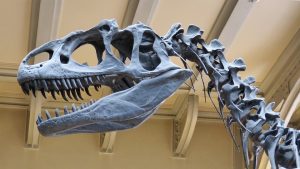I recently overheard a conversation between my granddaughter and a friend discussing what they’d learned in school that day. They were posed the question, ‘are birds dinosaurs?’, and given time to research the answer.
I was fairly surprised by their findings, so decided to dig a little deeper and share my own.
In my mind, dinosaurs were enormous, reptilian creatures that roamed the earth millions of years ago. They were nothing like the small, feathered creatures that regularly visit our gardens and parks. Even large birds of prey, such as vultures and hawks, bear little resemblance unless you consider the pterodactyl.
You may be astonished to learn that birds ARE dinosaurs, and they happily co-existed over 200 million years ago. They may not have looked much like the birds that we now recognise, but they are incredibly versatile and adapted to their conditions across the centuries.

Table of Contents
What happened to the dinosaurs?
Dinosaurs were the dominant land animal for hundreds of millions of years, during the Triassic period.
Then, 66 million years ago, a 10km wide asteroid collided with the earth, in the Yucatan Peninsula, Mexico.
It triggered volcanoes to erupt and unimaginably large Tsunamis to cover the entire land.
The earth was shrouded in thick dust clouds, it was dark and cold; it was mostly an inhospitable place for things to live and grow. Photosynthesis needs sunlight, without it, everything in the food chain above it perishes.
It resulted in mass destruction of the dinosaurs.
Yet somehow, one species survived – the birds.
How did birds survive when dinosaurs were wiped out?
It’s hard to believe that animals the size of ducks survived the mass extinction that wiped out the huge, powerful dinosaurs. But that is one of the reasons that ensured their safety; they were small.
- Size
Smaller animals need less food, which was just as well as it was scarce.
They also adapt to new conditions quickly, and, as their gestational times are short, they breed and reproduce faster.
- Diet
The birds were omnivorous; they eat anything they found. It included any plant or insect life, and fish.
They grew beaks, stronger, and better adapted to the circumstances. They evolved into hooks or drills, whichever design suited their feeding needs best.
Their ability to eat seed probably prevented their extinction along with the dinosaurs. Those with toothless beaks could forage for any remaining seeds that were protected beneath the ground.
- Flight
The ability to fly and escape threatening situations was a major contributing factor in preventing birds’ extinction.
Flying burns much fewer calories than walking or travelling, so they could cover great distances quickly. This proved useful as they were on the constant hunt for new food sources and places of safety.
The first birds
Believe it or not, birds are from the same family as the Tyrannosaurus Rex. They are called theropods and survived on a meat-based diet.
Archaeologists have studied the oldest bird fossils, over 150-million years old, and concluded that birds did look like smaller framed dinosaurs but with feathers.
The fossils showed some birds had teeth, others had small, rounded, beak-like protrusions, leading them to the conclusion that bird’s beaks, as we know them, evolved later. Any teeth helped them to cope with their meaty diet.
After the extinction of the dinosaurs, birds needed to adapt to survive. As their diet became more seed focused, their beaks grew to provide them with the perfect tool.
To this day, different birds have different size and shape beaks depending on what they eat. Finches have hooked beaks to tease open their favourite thistle pods, sparrows have short, robust beaks for eating grain.
Final thoughts
Because birds had the sense to adapt their diet to one of predominantly seed, they managed to outlive the mightiest of the dinosaurs.
Their evolution over millions of years leads to there being more than 11 thousand types of bird globally. They are one of the most diverse species of animal alive.
Birds thrive on every continent, in every extreme.
Are birds dinosaurs? Yes, and what they lack in the stature of a typical dinosaur, they make up for in wisdom, willingness to adapt, and longevity.
